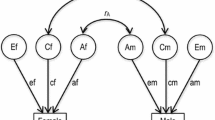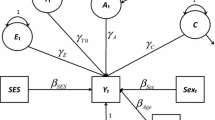Abstract
In this study, we examined genetic and environmental influences on covariation among two reading tests used in neuropsychological assessment (Cambridge Contextual Reading Test [CCRT], [Beardsall, L., and Huppert, F. A. (1994). J. Clin. Exp. Neuropsychol. 16:232–242], Schonell Graded Word Reading Test [SGWRT], [Schonell, F. J., and Schonell, P. E. (1960). Diagnostic and attainment testing. Edinburgh: Oliver and Boyd.]) and among a selection of IQ subtests from the Multidimensional Aptitude Battery (MAB), [Jackson, D. N. (1984). Multidimensional aptitude battery, Ontario: Research Psychologists Press.] and the Wechsler Adult Intelligence Scale-Revised (WAIS-R) [Wechsler, D. (1981). Manual for the Wechsler Adult Intelligence Scale-Revised (WAIS-R). San Antonio: The Psychological Corporation]. Participants were 225 monozygotic and 275 dizygotic twin pairs aged from 15 years to 18 years (mean, 16 years). For Verbal IQ subtests, phenotypic correlations with the reading tests ranged from 0.44 to 0.65. For Performance IQ subtests, phenotypic correlations with the reading tests ranged from 0.23 to 0.34. Results of Structural Equation Modeling (SEM) supported a model with one genetic General factor and three genetic group factors (Verbal, Performance, Reading). Reading performance was influenced by the genetic General factor (accounting for 13% and 20% of the variance for the CCRT and SGWRT, respectively), the genetic Verbal factor (explaining 17% and 19% of variance for the CCRT and SGWRT), and the genetic Reading factor (explaining 21% of the variance for both the CCRT and SGWRT). A common environment factor accounted for 25% and 14% of the CCRT and SGWRT variance, respectively. Genetic influences accounted for more than half of the phenotypic covariance between the reading tests and each of the IQ subtests. The heritabilities of the CCRT and SGWRT were 0.54 and 0.65, respectively. Observable covariance between reading assessments used by neuropsychologists to estimate IQ and IQ subtests appears to be largely due to genetic effects.
Similar content being viewed by others
References
Alarcón, M., and DeFries, J. C. (1997). Reading performance and general cognitive ability in twins with reading difficulties and control pairs. Personality and Individual Differences 22:793-803.
Beardsall, L. (1998). Development of the Cambridge Contextual Reading Test for improving the estimation of premorbid verbal intelligence in older persons with dementia. Br. J. Clin. Psychol. 37:229-240.
Beardsall, L., and Huppert, F. A. (1994). Improvement in NART word reading in demented and normal older persons using the Cambridge Contextual Reading Test. J. Clin. Exp. Neuropsychol. 16:232-242.
Brooks, A., Fulker, D. W., and DeFries, J. C. (1990). Reading performance and general cognitive ability: a multivariate genetic analysis of twin data. Personality and Individual Differences 11:141-146.
Cardon, L. R., DiLalla, L. F., Plomin, R., DeFries, J. C., and Fulker, D. W. (1990). Genetic correlations between reading performance and IQ in the Colorado Adoption Project. Intelligence 14:245-257.
Castles, A., Datta, H., Gayan, J., and Olson, R. K. (1999). Varieties of developmental reading disorder: genetic and environmental influences. J. Exp. Child Psychol. 72:73-94.
Crawford, J. R., Parker, D. M., Stewart, L. E., Besson, J. A. O., and DeLacey, G. (1989). Prediction of WAIS IQ with the National Adult Reading Test: cross-validation and extension. Br. J. Clin. Psychol. 28:267-273.
Crawford, J. R., Stewart, L. E., Cochrane, R., Parker, D. M., and Besson, J. A. O. (1989). Construct validity of the National Adult Reading Test: a factor analytic study. Personality and Individual Differences 10:585-587.
Eaves, L. J., Heath, A. C., and Martin, N. G. (1984). A note on the generalized effects of assortative mating. Behav. Genet. 14:371-376.
Franzen, M. D., Burgess, E. J., and Smith-Seemiller, L. (1997). Methods of estimating premorbid functioning. Arch. Clin. Psychol. 12:711-738.
Gayan, J., Datta, H. E., Castles, A., and Olson, R. K. (1997). The etiology of group deficits in word decoding across levels of decoding and orthographic coding. Paper presented at the meeting of the Society for the Scientific Study of Reading, Chicago, 23 March 1997.
Grayson, D. A. (1988). Twins reared together: minimizing shared environmental effects. Behav. Genet. 19:593-604.
Griffin, S. L., Rivera-Mindt, M., Rankin, E. J., Ritchie, A. J., and Scott, J. G. (2001). Estimating premorbid intelligence: comparison of traditional and contemporary methods across the intelligence continuum. Arch. Clin. Neuropsychol. 17:497-507.
Gustafsson, J-E., and Balke, G. (1993). General and specific abilities as predictors of school achievement. Multivariate Behavioural Research 28:407-434.
Hopper, J. L. (2000). Why 'common environmental effects' are so uncommon in the literature. In T. D. Spector, H. Sneider, and A. J. MacGregor (Eds.), Advances in twin and sib-pair analysis, London: Greenwich Medical Media, pp. 151-165.
Jackson, D. N. (1984). Multidimensional Aptitude Battery: Manual. Ontario, Canada: Research Psychologists Press, Inc.
Jensen, A. R. (1998). The g factor: the science of mental ability. Westport, CT: Praeger.
Jensen, A. R., and Weng, L-J. (1994). What is a good g. Intelligence 18:231-258.
Kaufman, A. S., and Lichtenberger, E. O. (1999). Essentials of WAIS-III assessment. New York: John Wiley & Sons, Inc.
Lastine-Sobecks, J. L., Jackson, S. T., and Paolo, A. M. (1998). Identifying the pronunciation of irregularly spelled words: relation to verbal IQ. Clin. Neuropsychol. 12:189-192.
Luciano, M. (2002). An information processing approach to the genetic study of psychometric intelligence: Links between processing speed, working memory and IQ. Ph.D. Thesis, University of Queensland, Queensland, Australia.
Luciano, M., Wright, M. J., Smith, G. A., Geffen, G. M., Geffen, L. B., and Martin, N. G. (2001). Genetic covariance among measures of information processing speed, working memory and IQ. Behav. Genet. 31:581-592.
Luciano, M., Wright, M. J., Geffen, G. M., Geffen, L. B., Smith, G. A., and Martin, N. G. (2003). A genetic two-factor model of the covariation among a subset of Multidimensional Aptitude Battery and WAIS-R subtests. Intelligence 31:589-605.
Neale, M. C., and Cardon, L. R. (1992). Methodology for genetic studies of twins and families. Norwell, MA: Kluwer Academic Publishers.
Nelson, H. E. (1982). National Adult Reading Test. Berkshire: NFERNelson Publishing Company.
Olson, R. K., Forsberg, H., and Wise, B. (1994). Genes, environment and the development of orthographic skill. In V. W. Berninger (Ed.), The varieties of orthographic knowledge I: theoretical and developmental issues. Dordrecht, The Netherlands: Kluwer Academic.
Olson, R. K., Wise, B., Conners, F., Rack, J., and Fulker, D. (1989). Specific deficits in component reading and language skills: genetic and environmental influences. J. Learn. Disabil. 22:339-348.
Petrill, S. A. (1997). Molarity versus modularity of cognitive functioning? A behavioral genetic perspective. Current Directions in Psychological Science 6:96-99.
Petrill, S. A., Luo, D., Thompson, L. A., and Detterman, D. K. (1996). The independent prediction of general intelligence by elementary cognitive tasks: genetic and environmental influences. Behav. Genet. 26:135-147.
Plomin, R., and Craig, I. (2001). Genetics, environment and cognitive abilities: review and work in progress towards a genome scan for quantitative trait locus associations using DNA pooling. Br. J. Psychiatry 178(Suppl. 40):s41-s48.
Rijsdijk, F. V., Vernon, P. A., and Boomsma, D. (1998). The genetic basis of the relation between speed-of-information processing and IQ. Behav. Brain Res. 95:77-84.
Rijsdijk, F. V., Vernon, P. A., and Boomsma, D. (2002). Application of hierarchical genetic models to Raven and WAIS subtests: a Dutch twin study. Behav. Genet. 32:199-210.
Schonell, F. J., and Schonell, P. E. (1960). Diagnostic and attainment testing. Edinburgh: Oliver and Boyd.
Stevenson, J. (1991). Which aspects of processing text mediate genetic effects. In B. F. Pennington (Ed.), Reading disabilities: genetic and neurological influences. Dordrecht, The Netherlands: Kluwer Academic Publishers, pp. 31-43.
Tabachnick, B. G., and Fidell, L. S. (1996). Using multivariate statistics (3rd Ed.), New York: Harper Collins.
Vernon, P. A. (2000). Recent studies of intelligence and personality using Jackson's Multidimensional Aptitude Battery and Personality Research Form. In R. D. Goffin and E. Helmes (Eds.), Problems and solutions in human assessment: honoring Douglas N. Jackson at seventy. Norwell, MA: Kluwer Academic Publishers, pp. 195-212.
Wadsworth, S. J., DeFries, J. C., Fulker, D. W., and Plomin, R. (1994). Covariation among measures of cognitive ability and academic achievement in the Colorado adoption project: sibling analysis. Personality and Individual Differences 18:63-73.
Wechsler, D. (1981). Manual for the Wechsler Adult Intelligence Scale-Revised (WAIS-R). San Antonio, TX: The Psychological Corporation.
Author information
Authors and Affiliations
Rights and permissions
About this article
Cite this article
Wainwright, M., Wright, M.J., Geffen, G.M. et al. Genetic and Environmental Sources of Covariance Between Reading Tests Used in Neuropsychological Assessment and IQ Subtests. Behav Genet 34, 365–376 (2004). https://doi.org/10.1023/B:BEGE.0000023642.34853.cb
Issue Date:
DOI: https://doi.org/10.1023/B:BEGE.0000023642.34853.cb




